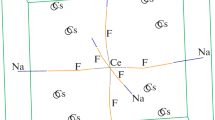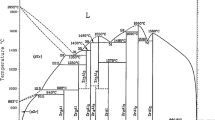Abstract
The binding energies in complex anions formed from the components Al–F, Zr–F, Al–O–F, and Zr–O–F are calculated by the ab initio Siesta molecular dynamics simulation. The formation of the anions is related to the dissolution of the ZrO2 and Al2O3 oxides in MF–AlF3 (M = Li, Na, K) fluoride melts. The influence of the element compositions of the anions and the cation from the second coordination sphere on the binding energies of the complex anions is determined. Among the oxygen-containing anions, the \({\text{A}}{{{\text{l}}}_{{\text{2}}}}{{{\text{O}}}_{{\text{2}}}}{\text{F}}_{{\text{6}}}^{{2 - }}\) and \({\text{Z}}{{{\text{r}}}_{{\text{2}}}}{{{\text{O}}}_{{\text{2}}}}{\text{F}}_{{\text{6}}}^{{2 - }}\) anions are shown to be most stable. Under identical conditions, the anions formed by zirconium are characterized by the lowest energy of the determining bond. The replacement of the cation in the second coordination sphere in the series from K to Li decreases the binding energy in the M2Al2O2F6 and M2Zr2O2F6 anions.




Similar content being viewed by others
REFERENCES
D. V. Ogorodov, D. A. Popov, and A. V. Trapeznikov, “Methods of preparing an Al–Zr master alloy (review),” Trudy VIAM, No. 11, 2–11 (2015).
K. E. Knipling, D. N. Seidman, and D. C. Dunand, “Ambient- and high-temperature mechanical properties of isochronally aged Al–0.06Sc, Al–0.06Zr, and Al–0.06Sc–0.06Zr (at %) alloys,” Acta Mater. 59, 943–954 (2011).
M. I. Gasik, N. P. Lyakishev, and B. I. Emlin, Theory and Practice of Manufacturing Ferroalloys (Metallurgiya, Moscow, 1988).
S. P. Yatsenko, B. V. Ovsyannikov, M. A. Ardashev, and A. N. Sabirzyanov, “Carbonization preparation of "master alloy” from fluoride–chloride melts,” Rasplavy, No. 5, 29–36 (2006).
V. I. Napalkov and S. V. Makhov, Alloying and Modification of Aluminum and Magnesium (MISIS, Moscow, 2002).
S. A. Krasikov, S. N. Agafonov, V. P. Chentsov, and E. M. Zhilina, “The effect of phase formation on the character of interphase interactions during aluminothermic reduction of zirconium from its dioxide,” Rasplavy, No. 2, 60–64 (2015).
S. N. Agafonov, S. A. Krasikov, A. A. Ponomarenko, and L. A. Ovchinnikova, “Phase formation in the aluminothermic reduction of ZrO2,” Neorg. Mater., 48, 927–934 (2012).
J. M. Juneja, “Preparation of aluminium–zirconium master alloys,” Ind. J. Eng. Mater. Sci. 9, 187–190 (2002).
P. S. Pershin, A. A. Filatov, A. V. Suzdal’tsev, Yu. P. Zaikov, “Aluminothermic preparation of Al–Zr alloys in the KF–AlF3 melt,” Rasplavy, No. 5, 413–421 (2016).
P. S. Pershin, A. A. Kataev, A. A. Filatov, A. V. Suzdal’tsev, and Yu. P. Zaikov, “Synthesis of Al–Zr alloys via ZrO2 aluminium-thermal reduction in KF–AlF3-based melts,” Met. Mater. Trans. B 48, 1962–1969 (2017).
A. A. Filatov, P. S. Pershin, A. Yu. Nikolaev, and A. V. Suzdal’tsev, “Synthesis of Al–Zr alloys and master alloys during the electrolysis of KF–NaF–AlF3–ZrO2 melts,” Tsvetn. Met., No. 11, 27–31 (2017).
E. Kubinakova, V. Danielik, and J. Hives, “Advanced technology for Al–Zr alloy synthesis: Electrochemical investigation of suitable low-melting electrolytes,” J. Alloys Compd. 738, 151–157 (2018).
A. A. Suzdal’tsev, A. A. Filatov, A. Yu. Nikolaev, A. A. Pankratov, N. G. Molchanova, and Yu. P. Zaikov, “Extraction of scandium and zirconium from their oxides during the electrolysis of oxide–fluoride melts,” Russ. Metall. (Metally), No. 1, 5–13 (2018).
A. A. Filatov, P. S. Pershin, A. V. Suzdaltsev, A. Yu. Nikolaev, and Yu. P. Zaikov, “Synthesis of Al–Zr master alloys via the electrolysis of KF–NaF–AlF3–ZrO2 melts,” J. Electrochem. Soc. 165 (2), E28–E34 (2018).
G. S. Picard, F. Seon, and B. Tremillon, “Oxoacidity reactions in molten lithium chloride + potassium chloride eutectic (at 470°C): potentiometric study of the equilibria of exchange of oxide ion between aluminum(III) systems and carbonate and water systems,” J. Electroanal. Chem. Interfac. Electrochem. 102 (1), 65–75 (1979).
G. S. Picard, F. Seon, B. Tremillon, and Y. Bertaud, “Effect of the addition of fluoride on the conditional solubility of alumina in lithium chloride–potassium chloride eutectic melt,” Electrochim. Acta, 25 1453–1462 (1980).
G. S. Picard, F. C. Bouyer, M. Leroy, Y. Bertaud, and S. Bouvet, “Structures of oxyfluoroaluminates in molten cryolite–alumina mixtures investigated by DFT-based calculations,” J. Mol. Struct. (Theochem) 368, 67–80 (1996).
E. Robert, J. E. Olsen, V. Danek, E. Tixhon, T. Ostvold, and B. Gilbert, “Structure and thermodynamics of alkali fluoride–aluminum fluoride–alumina melts. Vapor pressure, solubility, and Raman spectroscopic studies,” J. Phys. Chem. B 101, 9447–9456 (1997).
R. J. Thorne, C. Sommerseth, A. P. Ratvik, S. Rorvik, E. Sandnes, L. P. Lossius., H. Ling, and A. M. Svensson, “Correlation between coke type, microstructure, and anodic reaction overpotential in aluminium electrolysis,” J. Electrochem. Soc. 162 (12), E296–E306 (2015).
A. Y. Galashev and O. R. Rakhmanova, “Computer modeling of oxygen migration accompanying aluminum production,” Lett. Mater. 7 (4), 373–379 (2017).
A. Y. Galashev and O. R. Rakhmanova, “Computer study of oxygen release from Al melts,” Model. Simul. Mater. Sci. Eng. 26, 025003 (2017).
P. Hohenberg and W. Kohn, “Inhomogeneous electron gas,” Phys. Rev. B 136, 864–871 (1964).
W. Kohn and L. J. Sham, “Self-consistent equations including exchange and correlation effects,” Phys. Rev. A 140, 1133–1138 (1965).
J. P. Perdew, K. Burke, and M. Ernzerhof, “Generalized gradient approximation made simple,” Phys. Rev. Lett. 77, 3865–3868 (1996).
Author information
Authors and Affiliations
Corresponding author
Additional information
Translated by E. Yablonskaya
Rights and permissions
About this article
Cite this article
Vorob’ev, A.S., Suzdal’tsev, A.V. & Galashev, A.E. Binding Energies in the Molten M–Al–Zr–O–F Systems (M = Li, Na, K). Russ. Metall. 2019, 781–786 (2019). https://doi.org/10.1134/S0036029519080160
Received:
Revised:
Accepted:
Published:
Issue Date:
DOI: https://doi.org/10.1134/S0036029519080160




